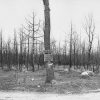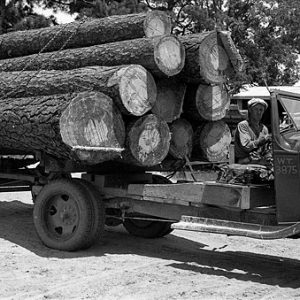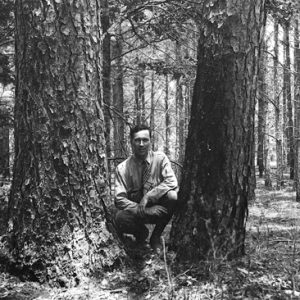calsfoundation@cals.org
Leslie Klett (Les) Pomeroy (1896–1976)
Although Sierra Club founder John Muir championed forest conservation by setting aside large acreages, it was Leslie Klett Pomeroy who devised a conservation plan for growing and harvesting timber that both conserved it and turned it into a renewable resource. His science-based management plans regenerated timberlands across the South after cut-out-and-get-out practices had decimated its forests. Pomeroy’s groundbreaking work carried out in Arkansas ultimately affected forestry in the South and across America.
Leslie Pomeroy was born on December 12, 1896, in Hub City, Wisconsin. He was the only child of William Justis Pomeroy and Anna Barbara Klett Pomeroy. His mother was a housewife, and his father began his employment with Madison Bus Company in 1922 as a motorman on streetcars, and he ultimately retired as a driver.
Pomeroy graduated from Central High School in Madison and enrolled in the University of Wisconsin in 1915, where he studied civil engineering. He worked part time in timber testing at the U.S. Forest Products Laboratory in Madison, along with his fellow student, Eugene P. Connor. In October 1917, when Pomeroy was in his third year, both men quit the university to enlist in the country’s armed services during the onset of World War I. Both were rejected due to physical technicalities, and they returned to the Forest Products Laboratory and engaged in research devoted to the kiln drying of timber products such as airplane propellers, gun stocks, and artillery carriages. Connor finished his engineering degree, but Pomeroy did not.
When the war ended in late 1918, Pomeroy conceived the idea of making a trip around the world to study forestry and related matters in foreign lands. On October 24, 1919, the two men sailed on the Monteagle from Vancouver, British Columbia, bound for Japan. With five letters of introduction, they managed to find work doing dry kiln consulting. They worked as seamen on a voyage that took them to the Philippines, Japan, China, Egypt, India, Siberia, and Italy, then across the European continent to do forestry research in France and England.
When they returned, Pomeroy and Connor were offered jobs in October 1920 by Edward J. Young, president of three large Southern lumber mills. They were sent to learn to cruise timber (that is, to measure standing timber), stack lumber, and other tasks pertaining to the manufacture of lumber. One of those companies was at Sylacauga, Alabama, where Pomeroy met Fay Roberts. They were married on November 24, 1923, and went on to have four children.
After two years of intensive training, Pomeroy and Connor returned to Madison, where they worked in sales and administrative work. On one selling trip, Pomeroy called on Herman Kessler, the owner of Stoughton Wagon Company, the maker of wagon wheel hubs. Due to declining business, Kessler wanted to sell a small Arkansas sawmill he co-owned in Wilmar (Drew County).
In 1925, Pomeroy and Connor moved to Arkansas and became owners of an abandoned sawmill in a ghost town with neither electricity nor running water. They started Ozark Badger Lumber Company, which included 160 acres of cut-over timberland, at a time when lumber companies had clear-cut and hauled timber out by railroad then moved away. Remaining sawmills had only a scant amount of timber left to cut. By selectively marking a few trees per acre to be cut, the land became productive enough to allow periodic timber cutting while the forest regenerated, and Pomeroy had become the “father of sustained yield.”
He was also the first to begin timber management by surveying land into forty-acre parcels. He was the first to cruise (measure standing timber) and establish the number of board feet per acre, then formulate a cutting plan to be carried out on five-year rotations, a practice that is still used today.
Pomeroy’s forest management concept was so impressive that, beginning in 1931, Yale University forestry students began coming to Arkansas every year through 1939 to study his methods and take their final examination in his forests. Three years later, senior Syracuse University forestry students followed suit.
Ozark Badger Lumber Company became the first to use trucks rather than trains for moving timber to their mill, thus making use of small tracts and selective marketing. They acquired cut-over timberland and then became a pioneer in keeping both written and photographic data on their process. In 1934, Pomeroy was one of twelve men selected by the Oberlaender Trust to make a six-week forestry tour of Germany, Czechoslovakia, and Austria. They arrived in Germany the night before Adolf Hitler came to power.
In May 1938, Pomeroy joined forces with Julian F. McGowin to form Pomeroy and McGowin Consulting Foresters, based in Monticello (Drew County). During the next fifty years, the company served as consultants to owners of over 50 million timbered acres in all the Southern states and several foreign countries. One of Pomeroy’s great achievements, with the aid of McGowin and Jim Girard of the U.S. Forest Service, was development of volume tables for measuring standing timber. These volume tables remain the stock-in-trade for today’s foresters.
The December 1939 issue of Readers’ Digest, in a piece condensed from an American Forests magazine article, featured the radical new concept of forest management as practiced by Pomeroy. The article, written by Samuel Lubell in collaboration with Al Pollard of Little Rock (Pulaski County), was titled “Pine Tree Bankers.” People learned of Pomeroy’s plan for cutting only such amounts of timber as would not impair continued growth, while keeping the amount of usable timber on a sustained level. Adopted across the South, the area became the “woodbasket of America.”
When World War II started in Europe in 1939, American lumber companies started shipping large amounts of lumber to the Allies, and Ozark Badger was among them. In early 1940, men who were unsympathetic with the Allies made efforts to stop them, and Pomeroy was confronted and threatened. Three days later, his dry kilns were burned to the ground.
The Ozark Badger Lumber Company added the Wilmar Company as a subsidiary for acquiring timberland. Both operations were successful, but in February 1965, due to changes within the industry, Ozark Badger ended forty years of sawmilling, concentrating on management and sale of standing timber. They auctioned off the mill and machinery. In 1971, Ozark Badger Lumber Company and the Wilmar Company were sold at competitive bid to Willamette Industries, Inc., which later assigned its rights under contract to Georgia-Pacific Corp., which became the final owner of the timberlands.
Pomeroy died on January 20, 1976, and is buried in Oakland Cemetery in Monticello (Drew County). Because of his interest in astronomy, Pomeroy Planetarium was named in his honor on the campus of what is now the University of Arkansas at Monticello.
For additional information:
Danielson, Kay Marnon. When Men Wore Ties in the Woods: Leslie Klett Pomeroy Travel, Forestry, and Photographs. N.p.: n.d. Online at https://www.blurb.com/books/2611393-when-men-wore-ties-in-the-woods-leslie-klett-pomer (accessed January 25, 2023).
Lubell, Samuel, and Al Pollard. “Pine Tree Bankers.” American Forests 45 (December 1939): 594–596.
———. “Pine Tree Bankers.” Readers’ Digest, December 1939, pp. 60–63. (Condensed from American Forests.)
Pomeroy, E. R. “Two Men and a Forest.” Drew County Historical Journal 4, no. 1 (1989): 47–70.
Pomeroy, L. K. “Applications of German Forestry to Conditions in the South.” Journal of Forestry 33 (January 1935): 16–19.
———. “Growing Trees for Market.” Southern Lumberman, March 1, 1950, p. 36.
Marcia Camp
Little Rock, Arkansas
 Early Twentieth Century, 1901 through 1940
Early Twentieth Century, 1901 through 1940 Environment
Environment Forest Management and Conservation
Forest Management and Conservation Ozark Badger Lumber Co. Truck
Ozark Badger Lumber Co. Truck  Les Pomeroy
Les Pomeroy 




Comments
No comments on this entry yet.